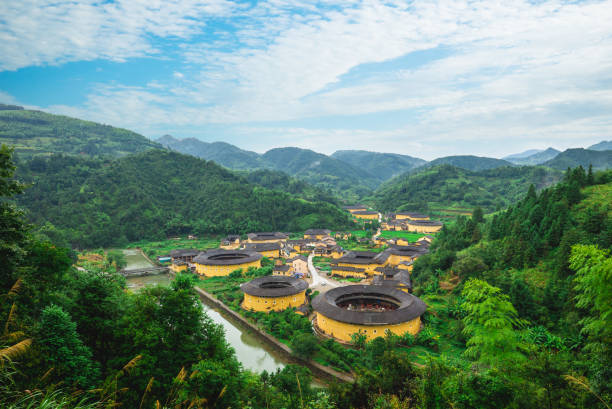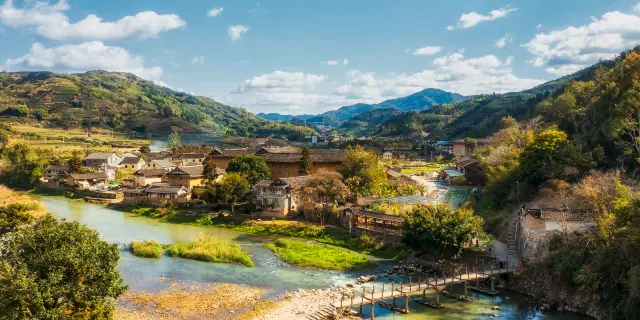Fujian’s Ancient City: A Photographer’s Paradise Awaits

An Essential Guide to Visiting Ancient City Of Fujian
Nestled within the breathtaking landscapes of southeastern China, the Ancient City of Fujian is a treasure trove of history, culture, and architectural marvels waiting to be explored. This storied region, which played a pivotal role in the maritime Silk Road, is where ancient traditions meet the serene beauty of nature. As you wander through its cobblestone streets, you’ll find yourself transported to a time when merchants traded silks and spices, and the echoes of scholars and poets filled the air.
The city is renowned for its unique Tulou buildings—massive, earthen structures that served as communal homes for families and clans, showcasing the ingenuity of ancient Chinese architecture. Beyond the Tulou, Fujian’s rich historical tapestry is woven with the legacies of legendary figures such as Zheng He and Lin Zexu, whose contributions have shaped not only the region but also the course of Chinese history.
With its mild climate, stunning mountain vistas, and vibrant culinary scene, Fujian is more than just a destination; it’s an invitation to immerse yourself in a world where the past comes alive. Whether you are sampling the famous Oolong tea, exploring ancient temples like the Nanputuo, or simply soaking in the picturesque scenery, the Ancient City of Fujian promises an unforgettable experience that resonates with adventure and discovery. Prepare yourself for a journey that transcends time and space, inviting you to delve deep into the heart of one of China’s most captivating provinces.
In This Guide
- An Essential Guide to Visiting Ancient City Of Fujian
- The Rich History and Legends of Ancient City Of Fujian
- Main Highlights: What You Absolutely Can’t Miss
- Planning Your Visit: A Practical Guide
- Tickets: Prices, Booking, and Tips
- How to Get There: A Complete Transportation Guide
- Local Cuisine and Accommodation Nearby
- Frequently Asked Questions
- Final Thoughts on Your Trip
The Rich History and Legends of Ancient City Of Fujian
Nestled in the southeastern corner of China, Fujian Province is a treasure trove of history and legends, with the ancient city of Fujian serving as a pivotal chapter in this rich narrative. This region, characterized by its stunning landscapes and vibrant culture, has long been a crossroads of trade, innovation, and cultural exchange, particularly during the era of the maritime Silk Road.
The ancient city of Fujian is often associated with the bustling trade hub of Quanzhou, which thrived as a major port from the 10th to the 14th centuries. This city was not only a gateway for merchants trading silk and porcelain but also a melting pot of cultures. Travelers from distant lands, including Arab, Indian, and Southeast Asian traders, converged here, leaving behind a legacy that is still visible today in the architecture and customs of the region. Quanzhou’s influence is evident in its diverse temples, mosques, and shrines, which reflect the harmonious coexistence of Buddhism, Taoism, Islam, and other religious practices.
Fujian’s history is also marked by legendary figures who played significant roles in shaping the region’s identity. One such figure is Zheng He, the famed Ming dynasty explorer who embarked on seven voyages across the seas, establishing maritime links with numerous countries. His journey began from the shores of Fujian, symbolizing not just the spirit of adventure but also the province’s historical significance in global trade and diplomacy.
Another noteworthy aspect of Fujian’s heritage is its unique architectural style, particularly the iconic Tulou structures found in the mountainous regions. These earthen buildings, recognized as UNESCO World Heritage Sites, were constructed by the Hakka people as communal residences. The Tulou, with their thick walls and round shapes, are not only functional but also represent a deep-seated cultural tradition of community living and defense against invaders.
In addition to its tangible heritage, Fujian is steeped in folklore and legends that illustrate the region’s cultural richness. Tales of local deities and spirits, often celebrated in traditional festivals, reveal the province’s deep-rooted beliefs and customs. The legend of the “Goddess of the Sea” (Mazu), who is said to protect fishermen and sailors, is particularly revered in coastal communities, reflecting the close relationship between the people and the sea.
Fujian’s historical narrative is also colored by its cuisine, a reflection of its diverse cultural influences. The province is known for its light, flavorful dishes, heavily featuring seafood, rice, and vegetables, which echo the harmonious blend of traditions that have coexisted here for centuries.
Today, as you wander through the ancient streets of Fujian, you can feel the echoes of its rich past. From the bustling markets of Quanzhou to the serene beauty of the Tulou villages, the ancient city of Fujian invites travelers to explore its historical depths while savoring the legends that continue to breathe life into its vibrant culture. Whether you are a history buff, a foodie, or an adventurer, Fujian promises a journey through time that will leave an indelible mark on your heart.

Ancient City Of Fujian.
Main Highlights: What You Absolutely Can’t Miss
Fujian Province, known for its stunning landscapes and rich history, offers travelers a treasure trove of experiences, especially in its ancient cities. Here are the highlights of the Ancient City of Fujian that you absolutely cannot miss:
1. The Tulou Buildings of Yongding
One of the most iconic sights in Fujian, the Tulou are large, circular earthen structures that served as communal living spaces for families. These UNESCO World Heritage Sites showcase incredible architecture and are surrounded by lush mountains. Be sure to explore the various types, including the famous round and square Tulou, and immerse yourself in the unique Hakka culture that thrives here.
2. Mount Wuyi (Wu Yi Shan)
A visit to Fujian would be incomplete without experiencing the breathtaking beauty of Mount Wuyi. This majestic mountain range is renowned for its stunning natural scenery, including towering cliffs, clear streams, and rich biodiversity. Hike through the lush trails, take a bamboo raft ride on the Nine-Bend River, and don’t forget to taste the local Oolong tea, which is celebrated for its exquisite flavor.
3. Gulangyu Island
Often referred to as “the Garden on the Sea,” Gulangyu Island is a pedestrian-only paradise just a short ferry ride from Xiamen. With its charming colonial architecture, lush gardens, and tranquil beaches, it’s the perfect spot for a leisurely day of exploration. Visit the Piano Museum, stroll along the winding paths, and indulge in the local delicacies at the street food stalls.
4. Nanputuo Temple
This ancient Buddhist temple, located at the foot of Wuyi Mountain, is one of the four most famous Buddhist temples in China. Its stunning architecture and serene atmosphere make it a must-visit. Spend time wandering through the intricately designed halls, admire the impressive statue of the Guanyin Bodhisattva, and enjoy the peaceful surroundings.
5. Chengqi Tower
An engineering marvel, Chengqi Tower is another UNESCO World Heritage Site located in the Yongding region. This five-story structure, built in the 19th century, is a perfect example of the traditional Tulou architecture. Climb to the top for panoramic views of the surrounding countryside, and learn about the history of this fascinating building.
6. Kaiyuan Temple
Dating back to the Tang Dynasty, Kaiyuan Temple in Quanzhou is one of the oldest temples in Fujian and is renowned for its impressive architecture and historical significance. Explore its beautifully landscaped grounds, listen to the temple bells, and marvel at the ancient sculptures and carvings that adorn its walls.
7. Local Culinary Delights
Fujian cuisine is famous for its light and fresh flavors, so be sure to indulge in local specialties. Try the Buddha Jumps Over the Wall soup, a luxurious dish filled with various seafood and delicacies, or sample some street food favorites like oyster omelets and rice dumplings.
8. Quanzhou’s Maritime Heritage
As the starting point of the Maritime Silk Road, Quanzhou is rich in maritime history. Visit the Quanzhou Maritime Museum to learn about its significance in ancient trade and explore the nearby ancient ports that tell the story of centuries of maritime activity.
9. Experience Local Culture
Engage with the vibrant local culture through traditional performances, local markets, and festivals. The Hui’an women, known for their distinctive attire and folk customs, are a living testament to Fujian’s rich heritage. Don’t miss the opportunity to witness their unique folk dances and musical performances.
10. Scenic Coastal Views
Fujian’s coastline is dotted with beautiful beaches and scenic spots. Take a day trip to explore the coastal towns and enjoy the stunning ocean views, fresh seafood, and vibrant local markets. Places like Xiamen and Fuzhou offer a blend of modernity and tradition, making them perfect for leisurely strolls and cultural exploration.
Whether you’re drawn to stunning landscapes, rich cultural heritage, or delicious cuisine, the Ancient City of Fujian promises an unforgettable journey through time and tradition. Make sure to take your time to explore these highlights, as they encapsulate the essence of this enchanting region.

Ancient City Of Fujian.
Planning Your Visit: A Practical Guide
Exploring the Ancient City of Fujian is a journey through time, offering visitors a glimpse into the rich tapestry of Chinese history, culture, and architecture. To ensure a smooth and enjoyable experience, here’s a practical guide to planning your visit.
Getting There
Fujian is well-connected through various modes of transport. The main cities to start your journey include:
- Fuzhou: The capital city, served by Fuzhou Changle International Airport, which has flights from major cities across China and some international destinations.
- Xiamen: Known for its picturesque landscapes and vibrant culture, it also has an international airport.
- Quanzhou: Accessible via the Quanzhou Jinjiang International Airport, this city is a historical hub.
Travelers can use high-speed trains to navigate between these cities, making it easy to reach the Ancient City of Fujian. Train tickets are affordable, with prices starting as low as $6.
Best Time to Visit
The ideal time to explore Fujian is during the spring (March to May) and autumn (September to November). During these months, the climate is pleasantly warm, and the natural beauty of the region is at its peak. Summers can be hot and humid, while winters are mild but can experience some rain.
Accommodations
Fujian offers a range of accommodation options to suit different budgets:
- Luxury Hotels: For a lavish stay, consider hotels in Xiamen or Fuzhou that provide exceptional service and amenities.
- Boutique Hotels: Experience local charm in boutique hotels that reflect the region’s unique architectural style.
- Budget Hostels: Ideal for backpackers, these hostels offer a more affordable yet comfortable stay.
Cultural Etiquette
Understanding local customs will enhance your experience:
- Language: While Mandarin is widely spoken, the local dialect (Min Chinese) is prevalent. Learning a few basic phrases can go a long way.
- Dining Etiquette: When dining, it is customary to share dishes. Try local specialties such as Oolong tea and Fujian cuisine, known for its light and fresh flavors.
- Respect for Traditions: When visiting temples or historical sites, dress modestly and follow any posted guidelines.
Key Attractions
The Ancient City of Fujian is surrounded by an array of cultural and natural sights:
- Fujian Tulou: These unique earthen structures, recognized as a UNESCO World Heritage site, are a must-visit for their architectural significance and historical context.
- Nanputuo Temple: One of China’s four renowned Buddhist temples, it offers serene surroundings and stunning views.
- Mount Wuyi: Famous for its beauty, this mountain range is ideal for hiking and enjoying nature.
- Gulangyu Island: A short ferry ride from Xiamen, this island is known for its colonial architecture and tranquil beaches.
Transportation Within Fujian
Local transportation is efficient and convenient:
- Public Transport: Buses and subways in cities like Fuzhou and Xiamen are reliable and easy to navigate.
- Taxis and Ride-Sharing: Taxis are readily available, and ride-sharing apps work well in urban areas.
- Bicycles: Rent a bicycle to explore Gulangyu Island or other scenic areas at your own pace.
Practical Tips
- Currency: The local currency is the Chinese Yuan (CNY). Credit cards are accepted in hotels and larger restaurants, but it’s advisable to carry cash for smaller vendors.
- Connectivity: Wi-Fi is widely available, but consider purchasing a local SIM card for better connectivity while traveling.
- Safety: Fujian is generally safe for tourists. However, as with any travel, remain vigilant and aware of your surroundings.
Conclusion
Your visit to the Ancient City of Fujian promises to be an enriching experience, blending history, culture, and breathtaking landscapes. With this practical guide, you’re well-equipped to navigate your journey and immerse yourself in all that this beautiful province has to offer. Enjoy your adventure!

Ancient City Of Fujian.
Tickets: Prices, Booking, and Tips
Visiting the Ancient City of Fujian is a journey back in time, offering a glimpse into the rich history and culture of this fascinating region. To ensure you have a smooth experience, here’s everything you need to know about ticket prices, booking, and essential tips for your visit.
Ticket Prices
Admission fees for the Ancient City of Fujian vary depending on the specific sites you wish to explore. Generally, you can expect:
- Entry to the Ancient City: Approximately CNY 50 to CNY 100 (about $7 to $14) per person.
- Guided Tours: If you prefer a guided experience, group tours typically range from CNY 200 to CNY 500 (about $28 to $70), which often include transportation and a knowledgeable guide.
- Discounts: Students, seniors, and children may be eligible for discounted rates, so it’s worth checking at the entrance or when booking online.
Booking Tickets
Booking your tickets in advance is highly recommended, especially during peak tourist seasons (March to May and September to November). Here are some options:
-
Online Booking: Many travel platforms and the official tourism website for Fujian offer online ticketing services. This can be a convenient option to secure your tickets ahead of time.
-
Local Travel Agencies: If you prefer in-person assistance, there are numerous travel agencies in Fujian that can help you book tickets and organize guided tours.
-
At the Entrance: Tickets can also be purchased at the entrance of the Ancient City. However, be prepared for potentially long lines, especially during busy seasons.
Tips for Your Visit
-
Plan Your Visit: Allocate a full day to explore the Ancient City, as there are numerous historical sites, museums, and cultural exhibitions to enjoy.
-
Dress Comfortably: Wear comfortable shoes and clothing, as you will be walking quite a bit on uneven surfaces.
-
Stay Hydrated: The climate in Fujian can be humid, so make sure to drink plenty of water throughout your visit.
-
Language Support: While English signage is available in many parts, consider downloading a translation app or learning a few basic phrases in Mandarin to enhance your experience.
-
Timing Your Visit: Arriving early in the morning can help you avoid crowds and give you a more intimate experience of the ancient architecture and serene surroundings.
With these insights, you are well-prepared to explore the Ancient City of Fujian. Enjoy your journey through this remarkable destination!
How to Get There: A Complete Transportation Guide
Getting to the Ancient City of Fujian (福建古城遗址) is an adventure that combines the beauty of coastal landscapes with the rich tapestry of history. Whether you’re traveling from within China or coming from abroad, this transportation guide will navigate you through the best options to reach this captivating destination.
Arrival by Air
Major Airports:
– Xiamen Gaoqi International Airport (XMN): Located approximately 130 km from the Ancient City, this airport is well-connected with international flights from major cities like Beijing, Shanghai, and Hong Kong, as well as domestic routes.
– Fuzhou Changle International Airport (FOC): About 200 km away, Fuzhou’s airport also serves numerous domestic and regional flights, making it a viable option for travelers looking to explore Fujian.
Getting to the City:
Upon arrival, you can take a taxi or ride-sharing service like Didi to reach the Ancient City. Alternatively, consider booking a shuttle bus if available, particularly from Xiamen, which often has direct routes to popular tourist sites.
Train Travel
China boasts an extensive high-speed rail network, making train travel a convenient and efficient option.
Train Stations:
– Xiamen Railway Station: From here, take a high-speed train to either Quanzhou or Fuzhou. Both cities are gateways to the Ancient City, with Quanzhou being the closer option at about 40 km away.
– Fuzhou Railway Station: If you arrive here, you can catch a local train or bus to Quanzhou or take a direct taxi.
Booking Tickets:
Tickets can be purchased online through various platforms, including the China Train Ticket website or the official high-speed rail app. Prices are generally affordable, with fares starting as low as $6.
Bus Services
For those considering a scenic route, long-distance buses operate regularly between major cities in Fujian.
Key Bus Stations:
– Quanzhou Long-Distance Bus Station: Frequent services run to the Ancient City, making it a practical choice for budget travelers.
– Fuzhou Long-Distance Bus Station: Similarly, buses from Fuzhou to Quanzhou take about 2 hours.
Check the schedules in advance as they can vary, especially during holidays.
Local Transportation
Once in the area, navigating to the Ancient City of Fujian can be done through several means:
- Public Buses: Local buses are a cost-effective option, with routes connecting major points of interest. Look for signs in English or ask locals for assistance.
- Taxis and Ride-Sharing: Taxis are readily available, and using ride-sharing apps like Didi can ease the language barrier.
- Bicycle Rentals: If you’re feeling adventurous, consider renting a bicycle to explore the picturesque surroundings at your own pace.
Tips for International Travelers
- Visa Requirements: Before traveling, ensure you check the latest visa regulations for your country, as China has specific entry requirements.
- Local Currency: The local currency is the Chinese Yuan (CNY). It’s advisable to have some cash on hand, although credit cards are widely accepted in urban areas.
- Language: While major tourist areas may have English signage, learning a few basic Mandarin phrases can enhance your experience.
Conclusion
Reaching the Ancient City of Fujian can be an easy and enjoyable experience with the right planning. Whether you choose to fly, take the train, or travel by bus, each option offers a unique glimpse into the stunning landscapes and vibrant culture of Fujian Province. Enjoy your journey into this historical treasure!

Ancient City Of Fujian.
Local Cuisine and Accommodation Nearby
When visiting the Ancient City of Fujian (福建古城遗址), you’ll find yourself immersed not only in its rich history but also in its vibrant local cuisine and comfortable accommodations that cater to international travelers.
Culinary Delights
Fujian cuisine, known for its light, fresh, and healthy flavors, is a must-try during your visit. Here are some dishes you shouldn’t miss:
-
Buddha Jumps Over the Wall (佛跳墙): This exquisite dish is a luxurious soup made with a variety of ingredients, including shark fin, abalone, and Chinese herbs. It’s said to be so aromatic that even a monk would jump over a wall to taste it!
-
Oyster Omelet (蚝煎): A popular street food, this dish combines fresh oysters with eggs, sweet potato starch, and a savory sauce. It’s a delicious representation of Fujian’s coastal flavors.
-
Fujian Fried Rice Noodles (福建炒米粉): Stir-fried rice noodles with vegetables, seafood, and a hint of soy sauce make for a hearty meal that’s both comforting and satisfying.
-
Steamed Dumplings (蒸饺): These delicate dumplings are filled with a variety of meats and vegetables, often served with a side of soy sauce or vinegar for dipping.
-
Oolong Tea (乌龙茶): Fujian is renowned for its Oolong tea, often enjoyed in traditional tea houses. Be sure to take a moment to savor this fragrant brew.
For an authentic dining experience, head to local restaurants or street vendors where you can enjoy these dishes freshly prepared. Notable spots include Quan Zhou Restaurant and Xiamen Seafood Market, both known for their diverse menus and welcoming atmospheres.
Where to Stay
After indulging in the local flavors, retreat to some of the nearby accommodations that offer both comfort and convenience:
-
Fujian Tulou Hotel: Located near the Tulou buildings, this hotel provides a unique experience, allowing travelers to immerse themselves in the local culture while enjoying modern amenities.
-
Xiamen Marriott Hotel: Just a short drive from the Ancient City, this hotel offers luxurious rooms with stunning views of the coast, along with excellent dining options and a relaxing spa.
-
Gulangyu Island Hotel: For a more tranquil setting, consider staying on Gulangyu Island. This hotel provides easy access to the island’s beautiful beaches and charming streets, making it a perfect getaway after a day of exploring.
-
Fuzhou Grand Hotel: Conveniently located in the capital city, this hotel offers spacious accommodations and is an excellent base for day trips to the Ancient City and other attractions in Fujian.
Choosing to explore the local cuisine and staying at one of these accommodations will undoubtedly enhance your experience in the Ancient City of Fujian, allowing you to create lasting memories of this enchanting destination. Enjoy your journey through history and flavor!

Ancient City Of Fujian.
Frequently Asked Questions
Frequently Asked Questions about the Ancient City of Fujian
1. What is the Ancient City of Fujian?
The Ancient City of Fujian refers to the historical sites and cultural heritage found in Fujian Province, particularly in cities like Quanzhou and Fuzhou. This area is rich in architecture, historical landmarks, and traditions that date back centuries, showcasing the province’s role in maritime trade and cultural exchange.
2. When is the best time to visit Fujian?
The ideal time to visit Fujian is during the spring (March to May) and autumn (September to November) months. During these periods, the weather is pleasant, making it easier to explore the outdoor attractions and historical sites.
3. How do I get to the Ancient City of Fujian?
Fujian is accessible via several transportation modes. The main cities, such as Fuzhou and Xiamen, have airports with domestic and international flights. Once you arrive, you can utilize trains, buses, or taxis to reach various historical sites within the province.
4. What are the must-see attractions in the Ancient City of Fujian?
Key attractions include the stunning Fujian Tulou, traditional earthen buildings that house communities, and the historic Kaiyuan Temple in Quanzhou. Don’t miss Mount Wuyi, known for its breathtaking landscapes and rich biodiversity, as well as Gulangyu Island’s unique architecture.
5. Is there a local cuisine I should try while visiting Fujian?
Absolutely! Fujian cuisine is renowned for its light, fresh flavors. Be sure to sample local specialties like Buddha Jumps Over the Wall, a rich soup, and various seafood dishes. Oolong tea from Fujian is also a must-try.
6. What language is spoken in Fujian?
The primary language spoken in Fujian is Min Chinese, which has various dialects depending on the region. However, Mandarin is also widely understood, especially in tourist areas.
7. Are there guided tours available for exploring the Ancient City of Fujian?
Yes, there are numerous guided tours available that focus on the ancient sites and cultural experiences in Fujian. Many local tour operators offer customizable packages that cater to different interests, from historical exploration to culinary experiences.
8. What should I pack for my trip to Fujian?
Pack light, breathable clothing suitable for humid weather, especially if you’re visiting during the summer months. Comfortable walking shoes are essential for exploring historical sites. Don’t forget an umbrella or raincoat, as Fujian experiences significant rainfall throughout the year.
Final Thoughts on Your Trip
As your journey through the Ancient City of Fujian comes to a close, take a moment to reflect on the rich tapestry of history, culture, and breathtaking landscapes that this remarkable region has to offer. From the majestic Mount Wuyi to the enchanting streets of Quanzhou and the iconic Tulou buildings, Fujian is a treasure trove of experiences waiting to be discovered.
The warmth of the local hospitality, the tantalizing flavors of Fujian cuisine, and the soothing essence of its renowned Oolong tea create lasting memories that will linger long after your visit. Whether you wandered through ancient temples, explored the coastal beauty of Gulangyu Island, or engaged with the vibrant traditions of the Hui’an women, each moment contributes to a narrative that is uniquely Fujian.
As you leave this ancient land, carry with you not just the sights you’ve seen, but the stories you’ve encountered and the connections you’ve made. There’s a magic in Fujian that beckons travelers to return, urging you to explore deeper and uncover even more of its mysteries. Until your next adventure, may the spirit of Fujian inspire you to embrace the journey ahead. Safe travels!